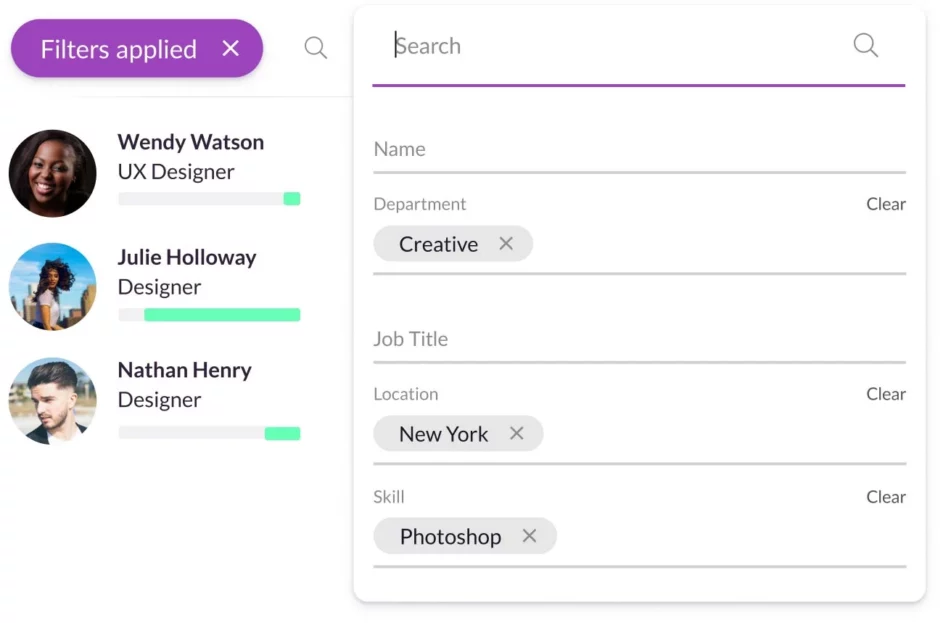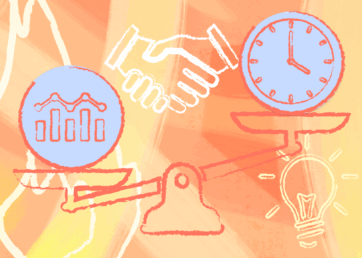What agency PM doesn’t love a process?
We’re going to reveal a nine-step agency project management process, including tips on how to best document each stage.
In this article 📖
The importance of an agency project management process
Processes provide the foundation for successful project execution and contribute to the overall success, competitiveness, and growth of agencies.
- Efficient resource utilization: Clear project management processes help agencies optimize resource allocation, ensuring that the right skills are assigned to the right projects. This leads to efficient resource utilization, prevents bottlenecks, avoids overallocation, and improves overall productivity.
- Effective time management: Project management processes enable agencies to plan and schedule tasks, set realistic timelines, and track progress. This ensures projects stay on track, deadlines are met, and time is managed effectively. The result? Reduced project delays and improved project outcomes.
- Client satisfaction: By aligning project goals, managing client requirements, and maintaining open communication, processes contribute to client satisfaction and help you go from client relationships to client partnerships.
- Risk mitigation: Effective project management processes facilitate risk identification, assessment, and mitigation. By proactively identifying potential risks, agencies can develop strategies to minimize their impact, manage uncertainties, and ensure project success.
- Quality assurance: You can’t talk about processes without talking about quality assurance. Here, it’s about creating processes that enable agencies to implement quality control measures and ensure the delivery of high-quality work. This includes processes like review cycles, testing procedures, and documentation standards. All the things that contribute to consistent and reliable project outcomes.
- Team collaboration: Believe it or not, processes are what foster collaboration and effective communication among team members. They provide structure, define project team roles and responsibilities, and establish channels for information sharing, leading to better teamwork altogether.
- Business growth and scalability: Standardized project management processes enable agencies to handle multiple projects and scale operations. By creating a framework for efficient project execution, it allows agencies to take on more clients, expand their services, and grow the business.
- Continuous Improvement: Well-established project management processes enable agencies to capture lessons learned, evaluate project performance, and polish up their practices. By analyzing past projects, identifying areas for improvement, and implementing process enhancements, agencies can continuously improve their project management capabilities. And with that, run an even better business.
While specific processes may vary between agencies, there are some guidelines you can follow when you’re implementing and refining your agency project management processes.
Let’s take a look.
Agency project management processes: 9 actionable steps to a better bottom line
Effective agency project management processes are the backbone of successful agency operations. These include all project activities such as project planning, resource allocation, task management, and quality control.
Here, we’ll take you through the nine steps of an effective agency project management process to help you create a smooth workflow.
Step 1. Discovery
The discovery stage (more popularly known as just “disco stage” among sales folks) aims to understand client needs, evaluate potential opportunities, and gather essential information to determine the fit between the client’s requirements and the agency’s capabilities.
Why the discovery stage is important:
The discovery stage is all about agency-client fit. The wrong type of client for your service offer can lead to poor service delivery and disappointed customers. A misaligned project will also waste a heck of a lot of team time. So use this stage to disqualify any mismatched leads (and save both prospect and agency time).
The discovery stage can take place via:
- A short discovery call
- In-person meeting (depending on your location)
- Some agencies ask prospects to fill out an initial questionnaire before organizing a meeting
You can also use this stage to get the info you need to outline the project scope. Of course, it’s still early days, so you can keep this as flexible as possible. But establishing a rough scope sooner rather than later can prevent (the much dreaded) scope creep later on.
Documenting the discovery stage
If you capture relevant information, you can create a proposal that meets the client’s needs, as highlighted in the discovery call.
Step 2. Proposal
If you’re a good agency-client fit, it’s time to go ahead with the proposal. Your client proposal should outline the project scope, timeline, budget, and deliverables as discussed during discovery. You should also provide clear criteria for project success that the client can sign off on.
Why the proposal stage is important:
The proposal stage allows the agency to present a detailed and tailored solution that addresses the client’s needs and requirements. It formalizes the proposed approach and sets clear expectations for both parties.
Documenting the proposal stage
Step 3. Kickoff
If you’ve reached the kickoff stage, congrats! Your client has now dotted the i’s and crossed the t’s on any formal contracts.
Now the kickoff stage officially begins.
Why the kickoff stage is important:
The kickoff stage marks the official start of the project and involves bringing together the project team, clarifying objectives, establishing communication channels, and setting the project in motion.
Here are four areas to consider during the kickoff stage:
- Define clear project objectives and deliverables. Let your team know the desired project outcomes and tangible results.
- Establish roles and responsibilities. Assign specific roles and responsibilities to team members and clarify their involvement in the project. Give them a clear picture of success and failure against each task.
- Set communication expectations (internally and externally). Choose the preferred communication channels, update frequency, and key contact points. This will help you collaborate effectively and share information throughout the project.
- Remember to request access to anything you might need from the client to initiate the project. If you’re a marketing agency, that could be access to social media accounts or company branding documents. For SEO agencies, you may need access to your client’s Google Search Console or website CMS.
By emphasizing the project’s purpose, highlighting its significance, and instilling a sense of purpose, the kickoff stage sets a positive tone and creates momentum for the project execution from day one.
Pro tip: We recommend hosting a kickoff meeting with your in-house team to get the most out of the kickoff stage. You can use this as an opportunity to gain feedback in preparation for the next stage.
Documenting the kickoff stage
Step 4. Planning
The goal of the planning stage is to create a detailed project plan to guide your project execution.
Why the planning phase is important:
The planning phase outlines the project scope, objectives, tasks, and milestones, providing a structured plan to guide the project team throughout the project life cycle. A well-defined plan ensures that everyone is aware of their responsibilities and the overall project direction.
Effective planning helps optimize resource allocation. It ensures that the right resources, including personnel, equipment, and budget, are allocated appropriately to support project activities. This prevents the overallocation or underutilization of resources, leading to improved efficiency and cost management.
To help you create your plan, you’ll need to:
- Identify resources. What people, tools, and budget do you need to ensure project success?
- Consider workload planning. How will you plan your team’s time so that key objectives are met but they’re not overbooked or burnt out?
- Do a risk assessment. Ask yourself:
- What potential risks and uncertainties could impact project success?
- What strategies could prevent those risks?
- How can you ensure proactive risk management throughout the project?
Here are some areas you should consider in your project plan:
- Timeline (broken into smaller deadlines and milestones)
- Specific tasks (including dependencies)
- Budget constraints
- Resource estimation (do you have the right people for the right tasks? And how much will you need them?)
- Resource availability (you know who you need and how much, but what’s their current availability?)
- Resource allocation (aka a flexible plan of how you’ll manage resources throughout the project timeline)
- Risk management factors (and how you’ll prevent them from negatively impacting project success)

Workload planning in Resource Guru, using filters to identify the right skills to assemble the best project team.
Documenting the planning stage
Step 5. Execution
In the project execution phase, you’ll start to implement your strategic project roadmap. That means you and your project delivery team will begin working through the tasks needed to achieve project goals.
Why the execution phase is important:
The execution phase is where the project plan comes to life. It involves executing the defined tasks, activities, and processes according to the established timeline and project requirements. This phase bridges the gap between planning and the actual realization of project outcomes.
Here are three areas to consider during the execution stage:
- Resource scheduling. Now you know who you need and how much, it’s time to schedule your team member’s time against tasks, skill sets, and availability.
- Task management. When you assign tasks to team members, establish clear goals and expectations. You also need to track task progress against expectations and the timeline.
- Communication and collaboration. Aim to keep team members, clients, and stakeholders informed, aligned, and engaged.
Documenting the execution stage
Step 6. Monitoring and control
Project monitoring and control happen throughout the agency project management process, from execution until project closure.
The main goal of monitoring and control is to track project progress and measure performance against your project plan. Doing so will help you catch bottlenecks early and make necessary changes to keep the project on track.
Key performance indicators (KPIs) and metrics are tracked to assess the project’s progress, resource utilization, cost performance, quality standards, and overall adherence to project objectives.
This provides insights into the project’s health and identifies areas that require improvement.
Why is the monitoring and control phase important?
Monitoring and control enable project managers to track the progress of project activities and deliverables. By regularly assessing the actual progress against the planned milestones and timelines, project managers can identify any deviations or delays early on and take necessary actions to address them.
Here are two monitoring and control areas to consider throughout the rest of the project:
- Track project progress, milestones, and key deliverables. Measure these against the project plan to identify any issues or delays.
- Assess project risks and monitor their impact. You want to weigh up the likelihood of project risks occurring. You’ll also want to introduce prevention strategies that minimize their potential to negatively impact project success.
Documenting the monitoring and control stage
Step 7. Review and feedback
Once you’ve completed the first versions of your project deliverables, it’s time for client review and feedback.
Why the review and feedback phase is important:
The review and feedback phase allows for an evaluation of the project’s performance against predefined goals and objectives. It provides an opportunity to assess whether the project is on track, identify areas of success, and determine any deviations or shortcomings that need to be addressed.
Think of this as a developmental review that gives you a chance to collect feedback. You can then ensure the project’s on track to meet client expectations.
If they love the deliverables already, great. If they have improvements and recommendations, don’t worry—you’ve built space to accommodate them.
Consider the following areas in the review and feedback stage:
- Host an in-house review and feedback session. Do this before you send the first drafts to clients. You can then find any issues (or correct embarrassing mistakes) and workshop through solutions internally.
- Client feedback analysis. Thoroughly review and analyze client feedback, including their comments and suggestions.
- Identify revision requests outside of the agreed scope. If there are any areas that are outside the agreed scope, suggest these as a separate project. Or ask to increase the budget and timeframe. Finally, consider any impact in-scope revisions may have on the original timeline.
- Formally agree on the next steps with your client. Agree with the client on how you’ll use their comments and suggestions within the revision stage. If there are any suggestions you feel would work against the project goals, politely and respectfully raise concerns with the client.
Documenting the review and feedback stage
Step 8. Revision
Hopefully, revisions have been formally agreed upon between you and the client. Now it’s time to make any revisions in line with client feedback and, if relevant, the amended scope.
Why the revision phase is important:
The revision phase helps teams identify any errors, mistakes, or discrepancies that may have occurred during the project execution. By detecting these errors early on, the team can take corrective measures and ensure that the final deliverables meet the desired quality standards.
The revision phase allows for the refinement and enhancement of the project deliverables, making sure your clients are happy with the final product.
Assigning revision tasks to your team is the main area to consider in the revision stage.
Documenting the revision stage
Step 9. Finalization (project closure)
Finalization (or project closure) aims to complete all project tasks, deliver the final product or service, and obtain sign-off from the client. And you want to do so in a way that creates normal project closure—aka, you completed on time and on budget.
Why the finalization (or project closure) phase is important:
The closure phase marks the formal end of the project. It provides a structured approach to wrap up all project activities and formally close the project. By completing the necessary administrative and logistical tasks, such as documenting lessons learned, archiving project documents, and conducting final reviews, the closure phase ensures that all loose ends are tied up and the project is officially concluded.
We recommend you take the following steps in your project closure process:
- Review the project plan to tie up loose ends
- Wrap-up admin tasks
- Close the loop with stakeholders (hand over deliverables and project documentation)
- Obtain official sign-off from the client
- Provide the next steps to your team
- Hold a project evaluation meeting (to identify areas for improvement and document lessons learned)
- Map out improvements for the future
- Index documentation
- Celebrate a job well done
Download your free project closure checklist, and close your project with confidence.
Documenting the finalization stage
Building scalable agency project management processes
Processes aren’t the sexiest topic, but it is what will set you up for growth.
Scalable processes allow for efficient agency project management processes across various projects and clients. They ensure that the project management framework can handle increased demands without sacrificing quality or performance.
Consider scalability from the outset of a project by anticipating potential growth, increased demands, and changing requirements. Build flexibility into your processes to accommodate new projects, larger teams, additional stakeholders, and evolving project complexities.
Remember that scalability is an ongoing process. Regularly assess your agency project management processes, gather feedback from stakeholders, and make necessary adjustments to support continued growth and adaptability.
This way, you’ll set up everyone for success.
A future of client-centric agency project management processes
Processes create consistency and reliability throughout the duration of the project. They enable effective communication and collaboration between clients, teams, and other stakeholders.
By streamlining workflows, eliminating bottlenecks, and optimizing resource allocation, projects can be completed on time and within budget. So come contract renewal season, you’re more likely to see ink on the dotted line.
Because in the end, the goal is to build long-term relationships that don’t feel like relationships, but rather—partnerships.
Did you know this is part three of our agency project management series?
Other parts in the series:
- Part 1: Agency project management 101
- Part 2: 5 PM methodologies for agencies
- Part 3: You’ve found it!
- Part 4: Agency team structure: How to build a winning agency team
- Part 5: Best agency project management software—10 tools you need to shortlist today




